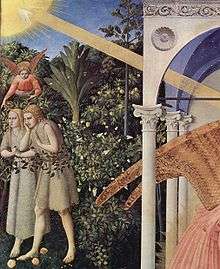Annunciation (Fra Angelico, Madrid)
The Annunciation is a panel-painting altarpiece or retable by Fra Angelico (tempera on panel, 154x194 cm the central panel, 194x194 including the predella) situated in the Museo del Prado of Madrid and created between the thirties of the 15th century. The work is probably the third of a series of great tables by Angelico representing the Annunciation; the other two are the Annunciation of Cortona and the Annunciation of San Giovanni Valdarno. Dating is not concordant and some art historians invert the sequence putting the Prado table at first.
| Annunciation | |
|---|---|
| Italian: Annunciazione | |
 The main panel | |
| Artist | Fra Angelico |
| Year | 1435 ca. |
| Medium | Tempera on panel |
| Dimensions | 154 cm × 194 cm (391 in × 493 in) |
| Location | Museo del Prado, Madrid |
History
The work has been painted in the Convent of San Domenico, Fiesole, where Angelico himself lived as a friar, and it was one of his biggest altarpiece in the church, with the main altarpiece on the high altar (the oldest one, 1424–25, and the only one still in the convent) and the Coronation of the Virgin in Louvre (1424-1435 circa).
The altarpiece was completed in 1435, when the works on the convent ended. After being sold, it became part of the royal collections of the Spanish monarchy before moving to Prado.
Description
The scenes have a structure similar to the other two Annunciations but with some differences. As in the Annunciation of Cortona, the pictured surface is divided in three parts (the garden, the Angel's arch and the Virgin's arch), but the vanishing point is inside the home and not outside, like the Annunciation of San Giovanni, focusing the viewer's attention on the Annunciation. Due to this scheme, the scene of Adam and Eve expelled from Eden could result less evident (in the Cortonese one they are near the vanishing point) if Angelico didn't increased considerably their figures.

As in the other two works, they are moving in a flowered garden representing the virginity of Mary ("hortus conclusus"), inhabited by a multitude of plants and seedlings painted with great accuracy. Between the species with symbolic values, we can recognise the palm, representing the future martyrdom of Christ, and the red roses referring the blood of the Passion. The presence of Adam and Eve evidences the cycle of the human damnation, recomposed with the deliverance in Christ made possible by the accept of Mary.
From the high-left a ray of divine light illuminates, through the dove of Holy Spirit, the Virgin, who bends accepting his duty submissively. She's sitting on a seat covered with a rich drape acting as carpet too, and she has on her knees an open book, symbol of the happening Scriptures.
The Angel has a similar pose and vest to the work of San Giovanni, even if his figure appears more static and the folds of the vest are more schematic, maybe due to the brush strokes of a collaborator.
The scene is set under a renaissance portico with the light arches stretched with wisdom on perspective, which remember the architecture of Michelozzo. Light appears unified, unlike the pail of Cortona, and moves from left to right for all the element.
The overall effect is of a precious description of the various details, with cold and bright colours, almost crystallized, in the changing colour harmonies of blue and pink.
Predella
In the predella there are five scenes from Mary's life ( Birth and Marriage, the Visitation, the Adoration of the Magi, Presentation at the temple and the dormition) where the master had worked freely on the composition, less subjected to the iconographic tradition of the main scene.
The Sposalizio presents the background of a Renaissance church with portico, while the visitation shows a sidelong lodge, represented with ability. This scene does not reach the vivid expression of fatigue on the woman who is going to the chime as in the predella of the Annunciation of Cortona. The Adoration of the Magi instead is completely original and shows an innovative frontal iconography years before the revolution of Botticelli (Adoration of the Magi in the Uffizi, 1475), enhanced by the complex perspective of the hut's ruins. Here can be noticed the distinct use of lights by Beato Angelico, who creates a pure and crystal illumination which models volumes, enhances the chromatic harmony and unifies the scenes.
The following scene of the Presentation is more innovative, with the ambient placed inside a circular temple which seems projected through lens to the viewer, improving the scheme already used on the Presentation at the Temple by Gentile da Fabriano. The Dormition is the most traditional scene though the invention of the avvallamento between the background mountains can be considered innovative, because it creates a perspective channel to the holy way suspended by the Angels on the top.
Bibliography
- Angelico Venturino Alce, Angelicus pictor: vita, opere e teologia del Beato Angelico, Edizioni Studio Domenicano, 1993. ISBN 88-7094-126-4
- Guido Cornini, Beato Angelico, Giunti, Firenze 2000 ISBN 88-09-01602-5
External links
| Wikimedia Commons has media related to Annunciation by Fra Angelico (Prado). |